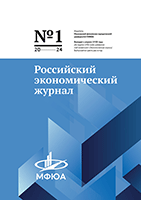Архив
Российский экономический журнал 1 / 2020
Построение нетривиальной экономико-математической модели для менеджмента производственных организаций
Рогулин Р.С.
Рогулин Р.С.,
ассистент кафедры прикладной математики, механики, управления и программного обеспечения школы естественных наук Дальневосточного федерального университета, ассистент кафедры математики и моделирования Владивостокского государственного университета экономики и сервиса
Аннотация. Автор предпринимает попытку обобщения (объединения, комбинирования, интегрирования) трех задач линейного программирования, известных теории и практике управления предприятиями реального сектора экономики. Имеются в виду «классическая» производственная задача, а также задачи «организация занятости средств производства» и «размещение центров». Решение первой задачи представляет собой вектор количества произведенных конечных продуктов, найденный с учетом ресурсных ограничений и необходимости максимизации прибыли. Вторая задача связана с размещением на поточных линиях рабочих попарно разных специальностей при том условии, что ни в одной из линий нет дублирующих профилей рабочих. Третья задача касается выбора пунктов производства из определенного ранее списка возможных мест. Интегральное целеполагание, объединяющее три указанные задачи (проблемы) в одну комплексную производственно-транспортную задачу (проблему), актуально для любых производственных организаций, которые намерены осваивать новые рынки и должны оптимизировать свои планы выпуска продукции (например, для предприятий лесоперерабатывающей промышленности, открывающих новые производственные цеха). Решение этой комплексной проблемы и оптимизация, о которой идет речь, по мнению автора, способна обеспечить построенная им обобщающая линейная смешанно-целочисленная модель.
Ключевые слова: линейное программирование, математическое моделирование, экономико-математическая модель, линейная смешанно-целочисленная модель, задача судоку, производственная задача, задача организации занятости средств производства, задача размещения центров, производственно-транспортная задача, оптимизация плана выпуска продукции.
BUILDING A NON-TRIVIAL ECONOMIC AND MATHEMATICAL MODEL FOR MANAGEMENT OF PRODUCTION ORGANIZATIONS
Rogulin R.S.,
Assistant of the Department of Applied Mathematics, Mechanics, Management and Software of the School of Natural Sciences of the Far Eastern Federal University, Assistant of the Department of Mathematics and Modeling of Vladivostok State University of Economics and Service
Abstract: The author makes an attempt to generalize (combining, integrating) three linear programming problems known to the theory and practice of managing enterprises in the real sector of the economy. This refers to the «classic» production task, as well as the «organization of employment of means of production» and «placement of centers». The solution to the first problem is a vector of the number of final products produced, which is found taking into account resource constraints and the need to maximize profits. The second task is related to the placement of workers in pairs of different specialties on production lines, provided that none of the lines have duplicate profiles of workers. The third task is to select production points from a previously defined list of possible locations. An integrated goal setting that combines the three specified tasks (problems) into one complex production and transport task (problem) is relevant for any production organizations that intend to develop new markets and must optimize their production plans (for example, for enterprises of the timber processing industry that open new production facilities).
According to the author, the generalizing linear mixed-integer model can provide a solution to this complex problem and the optimization in question.
Keywords: linear programming, mathematical modeling, economic and mathematical model, linear mixed-integer model, «Sudoku problem», production problem, organization of employment of means of production, problem of placement of centers, production and transport problem, optimization of the product release plan.
DOI: 10.33983/0130-9757-2020-1-108-116
Библиографический список
1. Алексеева Е.В. Построение математических моделей целочисленного линейного программирования. Примеры и задачи: учеб. пособие. — Новосибирск: Новосиб. гос. ун-т, 2012. — 131 с.
2. Писарук Н.Н. Исследование операций. — Минск: БГУ, 2015. — 304 с.
3. Coelho L., Laporte G.A. Comparison of several enumerative algorithms // Sudoku Journal of the Operational Research Society. — 2014. — Vol. 65. — Issue 10.
4. Hakimi S.L. Optimum distribution of switching centers in a communication network and somerelated graph theoretic problems // Operations Research. — 1965. — Vol. 13. — P. 462–475.
5. Oleinik E.B., Rogulin R.S. Sudoku: Another Aspect of the Application for Solving the Problem of Optimal Allocation of Resources. — URL: https://link.springer.com/chapter/10.1007/978-3-030-18553-4_65.
6. Solve Sudoku Puzzles Via Integer Programming: Problem-Based. — URL: https://www.mathworks.com/help/optim/examples/solve-sudoku-puzzles-via-integer-programming.html.
7. Takayuki Ya., Takahiro S. Complexity and Completeness of Finding Another Solution and Its Application to Puzzles. — URL: https://docplayer.net/27703695-Complexity-and-completenessof-finding-another-solution-and-its-application-to-puzzles.html.
8. Zhang L., Malik S. The quest for efficient boolean satisfiability solvers. — URL: https://link.springer.com/chapter/10.1007/3-540-45657-0_2.

